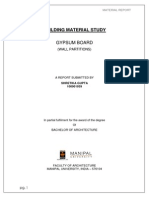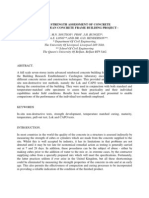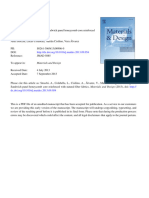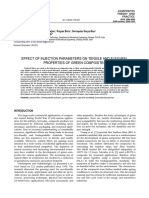Mechanical Properties of Gridcore Panels (FPL Spaceboard) Made From Compositions of Recycled Corrugated, Newsprint and Kenaf
Mechanical Properties of Gridcore Panels (FPL Spaceboard) Made From Compositions of Recycled Corrugated, Newsprint and Kenaf
Uploaded by
gemesh83Copyright:
Available Formats
Mechanical Properties of Gridcore Panels (FPL Spaceboard) Made From Compositions of Recycled Corrugated, Newsprint and Kenaf
Mechanical Properties of Gridcore Panels (FPL Spaceboard) Made From Compositions of Recycled Corrugated, Newsprint and Kenaf
Uploaded by
gemesh83Original Title
Copyright
Available Formats
Share this document
Did you find this document useful?
Is this content inappropriate?
Copyright:
Available Formats
Mechanical Properties of Gridcore Panels (FPL Spaceboard) Made From Compositions of Recycled Corrugated, Newsprint and Kenaf
Mechanical Properties of Gridcore Panels (FPL Spaceboard) Made From Compositions of Recycled Corrugated, Newsprint and Kenaf
Uploaded by
gemesh83Copyright:
Available Formats
MECHANICAL PROPERTIES OF GRIDCORETM a one-step forming process.
Additionally, the process could
PANELS (FPL SPACEBOARD) MADE FROM accommodate underutilized fiber sources such as mixed hard-
COMPOSITIONS OF RECYCLED CORRUGATED, woods and wastepaper. These two goals set the stage for
NEWSPRINT AND KENAF several breakthroughs in molded pulp processing technology at
FPL. Subsequent process improvements were developed by
C. Tim Scott Tim Newburn Hunt, Gunderson, Gleisner, and Scott (2-4). One of these
John F. Hunt Julee Herdt improvements was the development of a resilient mold con-
USDA Forest Service Colin Jessop taining an array of hexagonal (hex) pads. Spaceboard panels
Forest Products Laboratory1 Gridcore Systems International made from these hex molds results in the honeycomb rib
Madison, WI 53705-2398 Long Beach, CA 90813 structure shown in Figure 2.
In 1992, the Spaceboard patents (5-9) were licensed for
ABSTRACT specific fields of use in construction and furniture by Gridcore
Systems International (GSI). A Cooperative Research and
Development Agreement (CRADA) was initiated between FPL
and GSI to support the transfer of Spaceboard technology to
GRIDCORETM (FPL Spaceboard) is a three-dimensional, pulp- GSI. The hex mold concept was initially adopted because of
molded sandwich panel made by depositing and densifying a the many desirable features of the honeycomb panels. A
pulp slurry on a specifically designed resilient mold. Unlike significant research effort was undertaken by GSI to produce a
low density pulp-molded products, GRIDCORETM panels can new hex mold that would accommodate their production and
be highly densified to impart significant mechanical properties. marketing needs. Spaceboard panels made from these molds
This paper describes our initial efforts at producing became known as GRIDCORETM panels. In 1993, GSI was
GRIDCORETM panels from blends of old corrugated contain- awarded a grant from the USDA Alternative Agricultural
ers (OCC), old newsprint (ONP), and kenaf. The panels were Resource and Commercialization Center (AARC) to explore the
tested for edge crush strength, flat crush strength, bending commercial potential of producing Spaceboard panels produced
strength, and dimensional stability. The results indicate that from kenaf fiber.
desirable mechanical properties can be achieved from all panel
compositions. This report is a preliminary evaluation of the physical and me-
chanical properties of GRIDCORETM panels produced from
OCC, ONP, and kenaf as part of the AARC-funded study. All
panels were produced and tested at FPL as part of CRADA
BACKGROUND activities.
The development of new process technology to produce struc- TESTS ON GRIDCORETM PANELS
tural products from cellulose pulps has been an active area of
research at the USDA Forest Service, Forest Products Labora- Stock Preparation and Panel Production
tory (FPL). A decade ago, Setterholm (1) introduced the unique
method of forming a three-dimensional, waffle-like structure For this study, hammermilled kenaf stalks were obtained from
from molded wood pulp. He called the board “Spaceboard” KENAF International and shipped to Sprout-Bauer for
because of the open cells or “space” between the ribs of the thermomechanical refining. The hammermilled stalks were
“board” (Figure 1). At the time, Setterholm envisioned produc- soaked in water prior to refining, then fed into a pressurized
ing a Spaceboard panel that would have strength characteristics double-disk refiner at 2.07 bar steam pressure and a 1.5-min
similar to that of corrugated boxboard but could be produced in retention. A 2% sodium hydroxide charge was added to the kenaf
in the eye of the refiner. This first refiner pass resulted in a
shive content of 39% at 653 Canadian standard freeness (CSF).
1 A second refiner run was made in an atmospheric refiner to
The Forest Products Laboratory is maintained in cooperation
lower the shive content to 24% and freeness to 410 CSF. Both
with the University of Wisconsin. This article was written and OCC and ONP pulps were produced by hydropulping each at
prepared by U.S. Government employees on official time, and
3% consistency and 60°C. Neither pulp was refined before use.
it is therefore in the public domain and not subject to copy-
right. All GRIDCORETM panels were formed by the flow-through
The use of trade or firm names is for reader information and method of producing Spaceboard (2,5). This method incorpo-
does not imply endorsement by the U.S. Department of rates an integrated mold in which the hexagonal pads are con-
Agriculture of any product or service. nected to a wire screen (Fig. 3). First, a pulp slurry at 1% con-
1995 Recycling Symposium / 345
sistency is added to the deckle box, as shown in Figure 3a. With note, however, that bearing strength is directly affected by rib
the aid of an applied vacuum, the water is drawn through the alignment. Strength values can be severely compromised if the
screen. The wet mat is removed from the deckle box while still ribs are even slightly misaligned. To determine the bearing
on the mold. A screen is then placed on the top surface (facing) strength of fully aligned panels, unbonded half-panels or sub-
and the mat is placed in a hot press. As heat and pressure are panels were tested. These values are also listed in Table I.
applied, the hexagonal pads compress and deform laterally, den-
sifying the fiber web or “ribs” (Fig. 3b). Press conditions of Finally, each panel was tested for dimensional changes subject
175°C and 690 kPa were used on all panels. to a 60% variation in relative humidity (30% to 90% RH).
Because of the susceptibility of fiber-based panels to moisture,
Finished panels were nominally 1.2 m by 2.4 m and 9.5 mm particularly when no provision has been made to supplement
thick. Four pulp compositions were chosen for this study: 100% hydroxyl bonding, it is important to characterize dimensional
OCC, 100% kenaf, 50%-OCC/50%-kenaf, and 50%-kenaf/ stability if structural applications are being considered. Linear
25%-GCC/25%-GNP. Both heavy (7.5 kg) and light (5.5 kg) expansion and z-direction expansion were measured for all
panels were made from each composition. Each panel was cut panels (Table I).
into six segments. The segments were then paired and bonded
rib-to-rib to produce a test panel, using polyvinyl acetate CONCLUSIONS
adhesive.
Traditional pulp-molded products, such as egg cartons, are typi-
Tests on Mechanical Properties cally of low density and function primarily as cushioning for
packaging. At the Forest Products Laboratory, the development
Each test panel was cut into three 70-mm-wide strips for bend- of Spaceboard process technology has been an attempt to pro-
ing tests. The remaining 75-mm-wide strip was cut into 75-mm- duce highly densified, three-dimensional structures from paper
square blocks for edge crush and flat crush tests and one pulp. One of these structures is a GRIDCORETM panel. The
75-mm by 250-mm block for linear expansion measurements. hex mold configuration and process conditions used result in
All tests were implemented according to the appropriate ASTM panel facings with specific gravities near 1. At these densities,
standard protocol for sandwich panel construction. significant internal bond strength is developed and mechanical
properties suitable for structural applications can be achieved.
Two bending tests were implemented to determine modulus of For example, from bending tests at 50% RH, calculate MOE
elasticity (MOE), modulus of rupture (MOR), and type of fail- values ranged from 5 GPa for 100% OCC panels to 6 GPa for
ure. A 457-mm span was used for a center-point load bending 100% kenaf panels. The MOR values range from 20 to 35 MPa
test, and a 686-mm span was used for the third-point load bend- for the same respective panels. These values are very near re-
ing test. The width was chosen such that four ribs were aligned ported values for high density hardboard and above the geo-
parallel to the long axis of the beam. The tests revealed that the metric mean for high strength papers. Sheathing grade plywood,
MOE values range from 5 to 6 GPa (Table I) for panels tested at however, has about twice this strength. However, Spaceboard
50% relative humidity (RH) and from 2.5 to 4 GPa at 90% RH. has less than one-half the basis weight of an equivalent
Although most panel types failed in compression, the heavier, thickness of plywood.
blend panels were susceptible to shear stresses and resulted in
shear failures in the ribs, limiting the corresponding MOR One of the most desirable features of the Spaceboard forming
values. process, in terms of recycling, is the ability to tolerate “con-
taminated” fiber sources. The kenaf pulp used in this study had
Edge crush tests were implemented to determine the edge com- a rather high shive content (24%). This shive content is unac-
pression strength of panel blocks. Both gross compression ceptable for making paper but works well in Spaceboard.
strength and facing stresses were calculated and are listed in Therefore, pulps made from agricultural fiber sources such as
Table I. We anticipated an orientation effect as a result of the kenaf need not be reduced to single fibers, reducing both the
hexagonal geometry of the ribs, but this was not apparent in the energy required to produce pulp and damage to fiber integrity.
results. However, the rib structure did influence the type of fail- The ONP used in this study was not deinked. Drainage rates are
ures observed, especially in the light panels. This effect was an important aspect of the Spaceboard process and are affected
due to the lower density regions in the facing over the ribs. by contaminate level and mold design. Provisions can be made
to circumvent these problems.
Flat crush tests were implemented to determine the load bear-
ing potential of the ribs. Table I lists the gross fail stress mea- Although our results show that the mechanical properties of
sured for each panel composition produced. These results show Spaceboard may be suitable for structural applications, there
that panels made from 100% kenaf could sustain bearing stresses are other significant issues that must be addressed before it can
nearly 50% higher than 100% OCC panels. It is important to be used in these applications. Of utmost concern is the issue of
346 / TAPPI Proceedings
durability. To meet code requirements, sheathing panels must
pass a wet/redry cycle. Therefore, wet strength and stiffness
must be imparted to the panels. Other concerns are fire resis-
tance, pest and fungal resistance, and fastening requirements.
These areas are the focus of continued research under CRADA
activities with GSI.
REFERENCES
ACKNOWLEDGMENTS
This material is based upon work supported by the AARC Cen-
ter, U.S. Department of Agriculture, under Venture Capital
Agreement No. 93-AARC-1-0019.
Theodore Laufenberg (FPL), Robert Noble (GSI), and Joseph
Roetheli (AARC) were instrumental in developing the CRADA
and AARC agreements. Technical assistance was provided by
Rollie Gleisner (FPL), Chris Hunt (FPL), Rose Smyrski (FPL),
and Kermit Hovey (GSI).
1995 Recycling Symposium / 347
Table I - Physical and Mechanical Properties of GRIDCORE
100% OCC 100% KENAF 50% KENAF 50% KENAF
+ 50% OCC + 25% OCC
+ 25% ONP
Basis Weight (kg/m2) 4.3 4.4 4.2 4.0
Thickness (mm)
full panel 17.6 17.9 17.4 18.2
facing 1.85 1.96 1.83 1.78
rib 0.43 0.43 0.30 0.38
Density (g/cc)
full panel 0.24 0.25 0.24 0.22
facing 1.16 1.12 1.15 1.12
3rd point Bending @ 50%RH
MOE (GPa) 5.7 6.2 6.1 5.8
MOR (MPa) 27.2 34.7 25.3 24.1
failure mode comp comp shear shear
Centerpoint Bending @ 50%RH
MOE (GPa) 5.4 5.8 5.7 5.6
MOR (MPa) 24.3 35.7 27.1 29.3
failure mode comp comp shear comp
Centerpoint Bending @ 90%RH
MOE (GPa) 3.2 4.3 3.3 4
MOR (MPa) 12.9 24 16.1 19.3
failure mode comp comp shear comp
Edge Crush Test @ 50%RH
gross fail stress (kPa) 3.1 4.8 4.3 3.6
facing stress (MPa) 14.8 21.9 20.3 18.5
Edge Crush Test @ 90%RH
gross fail stress (kPa) 2.3 4.6 3.3 2.9
facing stress (MPa) 11.9 21.5 15.9 14.6
Flat Crush Test @ 50%RH
gross fail stress (kPa)
combined panel 403 442 280 338
sub-panel 398 634 470 521
Linear Expansion (%) 0.15 0.21 0.18 0.16
Thickness Swell (%) 1.5 1.5 1.4 1.3
348 / TAPPI Proceedings
1995 Recycling Symposium / 349
TM
Fig. 2. GRIDCORE hex mold and panel.
350 / TAPPI Proceedings
Fig. 3. Spaceboard forming process: (a) fiber is deposited on the mold as water drains through the wire screen;
(b) hexagonal pads deform laterally, densifying the webbing when normal pressure is applied.
1995 Recycling Symposium / 351
Technologoy Park/Atlanta
P.O. Box 105113
Atlanta, GA 30348-5113, USA
You might also like
- Answers To McNaughton Hearsay QuestionsDocument3 pagesAnswers To McNaughton Hearsay Questionsmnkysupafly2013100% (2)
- Animation in Design Systems PDFDocument39 pagesAnimation in Design Systems PDFKhoi PhamNo ratings yet
- Kalimtzis 2017 - An Inquiry Into The Philosophical Concept of Scholê - Leisure As A Political EndDocument240 pagesKalimtzis 2017 - An Inquiry Into The Philosophical Concept of Scholê - Leisure As A Political EndGaiuscunctator100% (1)
- Test Interpretation Skills For Career PlanningDocument32 pagesTest Interpretation Skills For Career PlanningLHOUIE GEE MOLLASGONo ratings yet
- Critical Attributes of Folding Cartons 2Document8 pagesCritical Attributes of Folding Cartons 2Wanda Yee100% (1)
- SCA Coffee Sustainability Program BrochureDocument7 pagesSCA Coffee Sustainability Program BrochureKushal Man Shrestha100% (1)
- Hybrid - Composite - Sandwich - Panels - Under - Blast - and - Impact LoadingDocument6 pagesHybrid - Composite - Sandwich - Panels - Under - Blast - and - Impact LoadingMuhammad HussainNo ratings yet
- Tappi Aug 2005 Articlemeand SchaepeDocument9 pagesTappi Aug 2005 Articlemeand SchaepeHilal AchrafNo ratings yet
- Buckling of Sandwich Composites Effects of Core-Skin Debonding and Core DensityDocument19 pagesBuckling of Sandwich Composites Effects of Core-Skin Debonding and Core DensityjavadNo ratings yet
- 2698-Article Text-4801-1-4-20221220Document9 pages2698-Article Text-4801-1-4-20221220Brahim NéciraNo ratings yet
- Performance of Low-Cost Vegetable Fibre-Cement Composites Under WeatheringDocument11 pagesPerformance of Low-Cost Vegetable Fibre-Cement Composites Under WeatheringJoseline CujilemaNo ratings yet
- Fractionation of Wood Due To Industrial Chipping: Effects and Potential For Kraft Pulping of European SpruceDocument14 pagesFractionation of Wood Due To Industrial Chipping: Effects and Potential For Kraft Pulping of European SprucemunozjuannNo ratings yet
- Design Proposal of A Prototype For Sawdust PelletDocument10 pagesDesign Proposal of A Prototype For Sawdust Pelletdare_numero5No ratings yet
- IIBCC2010 Proceedings Fracture Strength Fiber Cement Corrugated Sheets Statistical Approach Weibull AnalysisDocument14 pagesIIBCC2010 Proceedings Fracture Strength Fiber Cement Corrugated Sheets Statistical Approach Weibull AnalysiskhajuriaonlineNo ratings yet
- Bagasse-Reinforced Cement CompositesDocument6 pagesBagasse-Reinforced Cement CompositesEdem CHABINo ratings yet
- Cost and Weight Analysis of Ultra Thick Laminates For Compact Landing Gear FittingDocument8 pagesCost and Weight Analysis of Ultra Thick Laminates For Compact Landing Gear FittingyijunjieNo ratings yet
- Handlyup Vs VartmDocument8 pagesHandlyup Vs Vartms_padu3003@yahoo.comNo ratings yet
- Composites: Part B: Yicheng Du, Tongfei Wu, Ning Yan, Mark T. Kortschot, Ramin FarnoodDocument7 pagesComposites: Part B: Yicheng Du, Tongfei Wu, Ning Yan, Mark T. Kortschot, Ramin FarnoodWaleed ShakilNo ratings yet
- Cring of Reclaimed Asphalt PavementDocument8 pagesCring of Reclaimed Asphalt PavementKiplagat ChelelgoNo ratings yet
- IC Packaging Term Paper: Mariam HoseiniDocument8 pagesIC Packaging Term Paper: Mariam HoseiniAnastasia PodaraNo ratings yet
- Mud Block ConstructionDocument60 pagesMud Block ConstructionShretika GuptaNo ratings yet
- Modling Slit Tape Buckling During Automated Prepreg ManufacturingDocument9 pagesModling Slit Tape Buckling During Automated Prepreg Manufacturingpopmart21No ratings yet
- Universidad Técnica de Ambato Facultad de Ingeniería Civil Y Mecánica Carrera de Ingeniería Mecánica Diseño de Proyectos de InvestigaciónDocument23 pagesUniversidad Técnica de Ambato Facultad de Ingeniería Civil Y Mecánica Carrera de Ingeniería Mecánica Diseño de Proyectos de InvestigaciónAlex Mauricio Gualpa CaisachanaNo ratings yet
- Paper1 - Effect of Compaction Roller On Layup Quality and Defects Formation in Automated Fiber PlacementDocument18 pagesPaper1 - Effect of Compaction Roller On Layup Quality and Defects Formation in Automated Fiber Placementjaswanthraj2408No ratings yet
- Bambach 2019Document35 pagesBambach 2019Sofiene helailiNo ratings yet
- A Sreen-Caged Thermocouple PsychrometerDocument4 pagesA Sreen-Caged Thermocouple PsychrometerlorenaNo ratings yet
- 16Document26 pages16supriyo1970No ratings yet
- The Application of Composite Through-Thickness Assessment To Additively Manufactured StructuresDocument17 pagesThe Application of Composite Through-Thickness Assessment To Additively Manufactured StructuresDiego LeonNo ratings yet
- Processing of Grain-Size Functionally Gradient Bioceramics For Implant ApplicationsDocument7 pagesProcessing of Grain-Size Functionally Gradient Bioceramics For Implant ApplicationsKilaru Harsha VardhanNo ratings yet
- The Experimental Static Mechanical Performance of Ironed Repaired GFRP - Honeycomb Sandwich BeamsDocument22 pagesThe Experimental Static Mechanical Performance of Ironed Repaired GFRP - Honeycomb Sandwich BeamsdownrasNo ratings yet
- 2006 - Macrochanneled poly (ε-caprolactone) - hydroxyapatite scaffold by combination ofDocument6 pages2006 - Macrochanneled poly (ε-caprolactone) - hydroxyapatite scaffold by combination oformlove09No ratings yet
- Durability Based Design of FRP Jackets For Seismic Retrofit++Document11 pagesDurability Based Design of FRP Jackets For Seismic Retrofit++오상진No ratings yet
- IPTC 11465 Enhancing Natural Gas Purification With Advanced Polymer/Molecular Sieve Composite MembranesDocument6 pagesIPTC 11465 Enhancing Natural Gas Purification With Advanced Polymer/Molecular Sieve Composite MembranesKaroll GeraldineNo ratings yet
- Additive Manufacturing of Optically Transparent Glass PDFDocument14 pagesAdditive Manufacturing of Optically Transparent Glass PDFRangaNo ratings yet
- 4801 Ramrattan EvaluatingACeramicResin-CoatedDocument9 pages4801 Ramrattan EvaluatingACeramicResin-CoatedXantos YulianNo ratings yet
- Autoclaved Bamboo Pulp Fibre Reinforced Cement: R. S. P. CouttsDocument8 pagesAutoclaved Bamboo Pulp Fibre Reinforced Cement: R. S. P. Couttsakash kumarNo ratings yet
- Potential of Alternative Fibre Cements A PDFDocument8 pagesPotential of Alternative Fibre Cements A PDFBenharzallah KrobbaNo ratings yet
- Composites: Part A: Juan Pablo Vitale, Gaston Francucci, Jian Xiong, Ariel StocchiDocument9 pagesComposites: Part A: Juan Pablo Vitale, Gaston Francucci, Jian Xiong, Ariel Stocchiitsaashish12gmailcomNo ratings yet
- ABE 51 Case StudyDocument5 pagesABE 51 Case StudyKimberly Jane MitraNo ratings yet
- Thermoplastic Fabrication Technology Using Induced Vibration TechniquesDocument6 pagesThermoplastic Fabrication Technology Using Induced Vibration TechniquesabiliovieiraNo ratings yet
- 1 s2.0 S0263822397800086 MainDocument10 pages1 s2.0 S0263822397800086 MainAbdallah AbdalFatah Mohamed MohamedNo ratings yet
- Pressure Drop Modeling SiC FoamsDocument9 pagesPressure Drop Modeling SiC FoamsLykaios Schultz DohrnNo ratings yet
- Mechanical Properties and Production Quality of Hand-Layup and Vacuum Infusion Processed Hybrid Composite Materials For GFRP Marine StructuresDocument14 pagesMechanical Properties and Production Quality of Hand-Layup and Vacuum Infusion Processed Hybrid Composite Materials For GFRP Marine StructuresHENDRATO HENDRATONo ratings yet
- Analysis of Microporous Membranes Obtain - PDF (R-3) PDFDocument11 pagesAnalysis of Microporous Membranes Obtain - PDF (R-3) PDFFaaz AqeelNo ratings yet
- Structural Analysis of Laterally AeratedDocument9 pagesStructural Analysis of Laterally AeratedbailescuNo ratings yet
- Preparation and Properties Evaluation of Chitosan-Coated Cassava Starch FilmsDocument19 pagesPreparation and Properties Evaluation of Chitosan-Coated Cassava Starch FilmsAthiyah IskandarNo ratings yet
- UCLA Technical Report 2010 Advanced)Document11 pagesUCLA Technical Report 2010 Advanced)vkhansenNo ratings yet
- Cube TestDocument10 pagesCube Testridhuanzainal100% (1)
- Compression of GFRP Stiffened PanelsDocument7 pagesCompression of GFRP Stiffened PanelsGanesh MahidharNo ratings yet
- Synopsis: in This Project Used Different Materials. There AreDocument5 pagesSynopsis: in This Project Used Different Materials. There Areabdulhere4uNo ratings yet
- Iibcc O5-2Document10 pagesIibcc O5-2davidmonroybNo ratings yet
- Manufacturing and Testing of A Sandwich Panel Honeycomb Core Reinforced With Natural-Fiber FabricsDocument43 pagesManufacturing and Testing of A Sandwich Panel Honeycomb Core Reinforced With Natural-Fiber FabricsfredNo ratings yet
- 1 s2.0 002076839290207A MainDocument22 pages1 s2.0 002076839290207A MainrajeshcNo ratings yet
- Renamed 49854Document18 pagesRenamed 49854Siir Amine MilanoNo ratings yet
- Artigo ACE-X 2011Document13 pagesArtigo ACE-X 2011EdvaldoNo ratings yet
- Fractionation of Secondary Fiber AReviewDocument10 pagesFractionation of Secondary Fiber AReviewMiguel VenzNo ratings yet
- 1410 2022t04 Rajat Rathore Saugata enDocument9 pages1410 2022t04 Rajat Rathore Saugata enshimelis TameneNo ratings yet
- Hybrid Thermoplastic Composite Ballistic Helmet Fabrication StudyDocument11 pagesHybrid Thermoplastic Composite Ballistic Helmet Fabrication Studyt_unamNo ratings yet
- 2 SIM124 Freeform 3D Printing - Towards A Sustainable Approach To Additive Manufacturing Without Support MaterialsDocument5 pages2 SIM124 Freeform 3D Printing - Towards A Sustainable Approach To Additive Manufacturing Without Support Materialsryangy0919No ratings yet
- Comparison Between Honeycomb and Composite Corrugated Cores in Sandwich Panels Under Compression LoadingDocument14 pagesComparison Between Honeycomb and Composite Corrugated Cores in Sandwich Panels Under Compression LoadingDaniel StarrNo ratings yet
- Board Level Reliability Study of Next Generation Large Die WLCSPDocument9 pagesBoard Level Reliability Study of Next Generation Large Die WLCSPChristian HollaenderNo ratings yet
- Mechanical Property Evaluation of Jute-GlassDocument6 pagesMechanical Property Evaluation of Jute-GlassiaetsdiaetsdNo ratings yet
- Jinkarn 2006Document8 pagesJinkarn 2006Pacing LIfeNo ratings yet
- Composite Fabrication Via The VARTM ProcessDocument7 pagesComposite Fabrication Via The VARTM ProcessRaghu Raja PandiyanNo ratings yet
- Lime Hemp and Rice Husk-Based Concretes for Building EnvelopesFrom EverandLime Hemp and Rice Husk-Based Concretes for Building EnvelopesNo ratings yet
- Technical Data Sheet: Welsconda Co.,LimitedDocument1 pageTechnical Data Sheet: Welsconda Co.,LimitedAnu ShanthanNo ratings yet
- Heat Transfer in Internal Combustion EnginesDocument7 pagesHeat Transfer in Internal Combustion EnginesMishelNo ratings yet
- How Did Life Begin On EarthDocument2 pagesHow Did Life Begin On EarthKC Glenn DavidNo ratings yet
- Minute Meeting FluidDocument5 pagesMinute Meeting FluidKerol Kerol KerolNo ratings yet
- Log Notes PDFDocument3 pagesLog Notes PDFSharon ChuaNo ratings yet
- Vivid SydneyDocument3 pagesVivid Sydneysandhorac7453No ratings yet
- Sell V1Document5 pagesSell V1Rakshit DattaniNo ratings yet
- List of Architects Revised On 26-05-Ef09Document8 pagesList of Architects Revised On 26-05-Ef09Harish ArnepalliNo ratings yet
- Eliwell 978 ManualDocument12 pagesEliwell 978 ManualDuy DKNo ratings yet
- IS.3028 - Noise Test Area RequirementsDocument6 pagesIS.3028 - Noise Test Area Requirementsmano3mmmNo ratings yet
- Compare Current Source Inverter (CSI) and Voltage Source Inverter (VSI) - Electrical RevolutionDocument1 pageCompare Current Source Inverter (CSI) and Voltage Source Inverter (VSI) - Electrical RevolutionSushil NamoijamNo ratings yet
- ACTG6492 - Midterm Quiz 1 - Attempt ReviewDocument2 pagesACTG6492 - Midterm Quiz 1 - Attempt ReviewKinglaw PilandeNo ratings yet
- Mindfulness DiaryDocument1 pageMindfulness Diary장채윤No ratings yet
- Mathcad - 5Document4 pagesMathcad - 5Desejo SozinandoNo ratings yet
- Gasoline - Density, Melting Point, Thermal ConductivityDocument7 pagesGasoline - Density, Melting Point, Thermal ConductivityMinh DoNo ratings yet
- Datasheet R2000iADocument4 pagesDatasheet R2000iArockNo ratings yet
- Interview On ElectronicsDocument2 pagesInterview On Electronicsgvrao578No ratings yet
- Advance Forming TechDocument18 pagesAdvance Forming TechNicholas DarielNo ratings yet
- PetroMod TecLinkDocument2 pagesPetroMod TecLinkAnggara Putra100% (1)
- Fruit 1Document181 pagesFruit 1jemal abafitaNo ratings yet
- Chapter 1. Physical Measurement P1 Q DavidDocument13 pagesChapter 1. Physical Measurement P1 Q DavidthisishouweiNo ratings yet
- Aligarh Muslim University: Malappuram Centre, KeralaDocument16 pagesAligarh Muslim University: Malappuram Centre, KeralaHarendra TeotiaNo ratings yet
- Installation Instructions Model HZM: Remote Conventional Zone ModuleDocument8 pagesInstallation Instructions Model HZM: Remote Conventional Zone ModuleTelecom OperacionesNo ratings yet
- Influences of Online Store Perception, Shopping Enjoyment and Shopping Involvement On Consumer Patronage Behavior Towards An Online RetailerDocument13 pagesInfluences of Online Store Perception, Shopping Enjoyment and Shopping Involvement On Consumer Patronage Behavior Towards An Online Retailerlem123anNo ratings yet
- Mutually InclusiveDocument3 pagesMutually InclusiveKeesha MashNo ratings yet

























































































